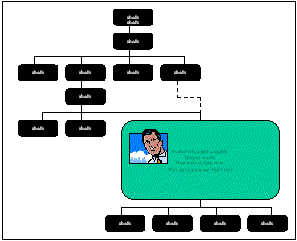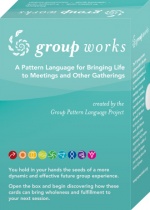 We’ve all seen and used the online mapping services like Mapquest and Mappoint that will give you an instant map, and driving directions, for any address on the planet. So how come this technology hasn’t been adapted to the corporate market, so that any employee of a large organization can see, visually, where any other employee fits in the organizational structure? Such an innovation would seem to have lots of benefits: We’ve all seen and used the online mapping services like Mapquest and Mappoint that will give you an instant map, and driving directions, for any address on the planet. So how come this technology hasn’t been adapted to the corporate market, so that any employee of a large organization can see, visually, where any other employee fits in the organizational structure? Such an innovation would seem to have lots of benefits:
Presumably Mapquest and Mappoint are database-driven, which suits this technology perfectly for a corporate application. While even a single hierarchical view of every employee in the company would be a great advance, such a structure would even allow the increasingly ‘matrixed’ organization to show employees and relationships in multiple ways: (a) their geographic ‘location’, (b) their functional/heirarchical ‘location’, (c) their membership and position in cross-functional, cross-geography communities and networks, etc. And the ‘drill down’ functionality would allow you to see exactly where the employee sits at any level of granularity from a physical layout of a single office floor to the 30,000 foot view from the executive suite, where the employee would appear as a mere ‘dot’ (but where the chain of responsibility up would still be visible, so one can go through ‘channels’ if appropriate). I remember seeing something like this from a colleague in the banking industry a while ago, so I’m sure such a thing exists. If anyone knows of existing commercial products that meet these requirements, or ‘best practices’ that have been put together by companies for their own needs, I’d like to hear about them. If there aren’t any, there may be an opportunity here for a great new, useful software product. |
Navigation
Collapsniks
Albert Bates (US)
Andrew Nikiforuk (CA)
Brutus (US)
Carolyn Baker (US)*
Catherine Ingram (US)
Chris Hedges (US)
Dahr Jamail (US)
Dean Spillane-Walker (US)*
Derrick Jensen (US)
Dougald & Paul (IE/SE)*
Erik Michaels (US)
Gail Tverberg (US)
Guy McPherson (US)
Honest Sorcerer
Janaia & Robin (US)*
Jem Bendell (UK)
Mari Werner
Michael Dowd (US)*
Nate Hagens (US)
Paul Heft (US)*
Post Carbon Inst. (US)
Resilience (US)
Richard Heinberg (US)
Robert Jensen (US)
Roy Scranton (US)
Sam Mitchell (US)
Tim Morgan (UK)
Tim Watkins (UK)
Umair Haque (UK)
William Rees (CA)
XrayMike (AU)
Radical Non-Duality
Tony Parsons
Jim Newman
Tim Cliss
Andreas Müller
Kenneth Madden
Emerson Lim
Nancy Neithercut
Rosemarijn Roes
Frank McCaughey
Clare Cherikoff
Ere Parek, Izzy Cloke, Zabi AmaniEssential Reading
Archive by Category
My Bio, Contact Info, Signature Posts
About the Author (2023)
My Circles
E-mail me
--- My Best 200 Posts, 2003-22 by category, from newest to oldest ---
Collapse Watch:
Hope — On the Balance of Probabilities
The Caste War for the Dregs
Recuperation, Accommodation, Resilience
How Do We Teach the Critical Skills
Collapse Not Apocalypse
Effective Activism
'Making Sense of the World' Reading List
Notes From the Rising Dark
What is Exponential Decay
Collapse: Slowly Then Suddenly
Slouching Towards Bethlehem
Making Sense of Who We Are
What Would Net-Zero Emissions Look Like?
Post Collapse with Michael Dowd (video)
Why Economic Collapse Will Precede Climate Collapse
Being Adaptable: A Reminder List
A Culture of Fear
What Will It Take?
A Future Without Us
Dean Walker Interview (video)
The Mushroom at the End of the World
What Would It Take To Live Sustainably?
The New Political Map (Poster)
Beyond Belief
Complexity and Collapse
Requiem for a Species
Civilization Disease
What a Desolated Earth Looks Like
If We Had a Better Story...
Giving Up on Environmentalism
The Hard Part is Finding People Who Care
Going Vegan
The Dark & Gathering Sameness of the World
The End of Philosophy
A Short History of Progress
The Boiling Frog
Our Culture / Ourselves:
A CoVid-19 Recap
What It Means to be Human
A Culture Built on Wrong Models
Understanding Conservatives
Our Unique Capacity for Hatred
Not Meant to Govern Each Other
The Humanist Trap
Credulous
Amazing What People Get Used To
My Reluctant Misanthropy
The Dawn of Everything
Species Shame
Why Misinformation Doesn't Work
The Lab-Leak Hypothesis
The Right to Die
CoVid-19: Go for Zero
Pollard's Laws
On Caste
The Process of Self-Organization
The Tragic Spread of Misinformation
A Better Way to Work
The Needs of the Moment
Ask Yourself This
What to Believe Now?
Rogue Primate
Conversation & Silence
The Language of Our Eyes
True Story
May I Ask a Question?
Cultural Acedia: When We Can No Longer Care
Useless Advice
Several Short Sentences About Learning
Why I Don't Want to Hear Your Story
A Harvest of Myths
The Qualities of a Great Story
The Trouble With Stories
A Model of Identity & Community
Not Ready to Do What's Needed
A Culture of Dependence
So What's Next
Ten Things to Do When You're Feeling Hopeless
No Use to the World Broken
Living in Another World
Does Language Restrict What We Can Think?
The Value of Conversation Manifesto Nobody Knows Anything
If I Only Had 37 Days
The Only Life We Know
A Long Way Down
No Noble Savages
Figments of Reality
Too Far Ahead
Learning From Nature
The Rogue Animal
How the World Really Works:
Making Sense of Scents
An Age of Wonder
The Truth About Ukraine
Navigating Complexity
The Supply Chain Problem
The Promise of Dialogue
Too Dumb to Take Care of Ourselves
Extinction Capitalism
Homeless
Republicans Slide Into Fascism
All the Things I Was Wrong About
Several Short Sentences About Sharks
How Change Happens
What's the Best Possible Outcome?
The Perpetual Growth Machine
We Make Zero
How Long We've Been Around (graphic)
If You Wanted to Sabotage the Elections
Collective Intelligence & Complexity
Ten Things I Wish I'd Learned Earlier
The Problem With Systems
Against Hope (Video)
The Admission of Necessary Ignorance
Several Short Sentences About Jellyfish
Loren Eiseley, in Verse
A Synopsis of 'Finding the Sweet Spot'
Learning from Indigenous Cultures
The Gift Economy
The Job of the Media
The Wal-Mart Dilemma
The Illusion of the Separate Self, and Free Will:
No Free Will, No Freedom
The Other Side of 'No Me'
This Body Takes Me For a Walk
The Only One Who Really Knew Me
No Free Will — Fightin' Words
The Paradox of the Self
A Radical Non-Duality FAQ
What We Think We Know
Bark Bark Bark Bark Bark Bark Bark
Healing From Ourselves
The Entanglement Hypothesis
Nothing Needs to Happen
Nothing to Say About This
What I Wanted to Believe
A Continuous Reassemblage of Meaning
No Choice But to Misbehave
What's Apparently Happening
A Different Kind of Animal
Happy Now?
This Creature
Did Early Humans Have Selves?
Nothing On Offer Here
Even Simpler and More Hopeless Than That
Glimpses
How Our Bodies Sense the World
Fragments
What Happens in Vagus
We Have No Choice
Never Comfortable in the Skin of Self
Letting Go of the Story of Me
All There Is, Is This
A Theory of No Mind
Creative Works:
Mindful Wanderings (Reflections) (Archive)
A Prayer to No One
Frogs' Hollow (Short Story)
We Do What We Do (Poem)
Negative Assertions (Poem)
Reminder (Short Story)
A Canadian Sorry (Satire)
Under No Illusions (Short Story)
The Ever-Stranger (Poem)
The Fortune Teller (Short Story)
Non-Duality Dude (Play)
Your Self: An Owner's Manual (Satire)
All the Things I Thought I Knew (Short Story)
On the Shoulders of Giants (Short Story)
Improv (Poem)
Calling the Cage Freedom (Short Story)
Rune (Poem)
Only This (Poem)
The Other Extinction (Short Story)
Invisible (Poem)
Disruption (Short Story)
A Thought-Less Experiment (Poem)
Speaking Grosbeak (Short Story)
The Only Way There (Short Story)
The Wild Man (Short Story)
Flywheel (Short Story)
The Opposite of Presence (Satire)
How to Make Love Last (Poem)
The Horses' Bodies (Poem)
Enough (Lament)
Distracted (Short Story)
Worse, Still (Poem)
Conjurer (Satire)
A Conversation (Short Story)
Farewell to Albion (Poem)
My Other Sites





Nice idea, and it seems to me that soem of the capabilities of Valdis Kreb’s Inflow Software (www.orgnet.com), or Karen Stephenson’s Netform can either come close to doing this, or offer similar views on nodes, collectors, hubs, etc. of knowledge, in organizations where that is deemed to be important to know.It may not be as “quick-and-easy” as MapQuest, but then again, maybe this wouldn’t be such a great idea except in organizations where there isn’t the possibility of the “dark side” of such transparency being exploited. I think the issue of how closely employees should and will be subject to surveillance is hugely fascinating.By the way, do you know of Trilogy’s software, at http://www.leadership.com ? It’s also very interesting, purports to be able to see and monitor and communicate with the “whole system”.
Sorry, can’t help myself. The org-chart map still begs the issue of how organizations place employees in relation to each other. I worked for Hay Management Consultants for quite a while, and if more people knew more about the arcane “science” (or black art) of job evaluation – and if you believe that language creates reality – then there would be a much closer examination of the language that underpins the design, and therefore a fair amount of the behaviour generated in/by, a chart of an organization. It’s no accident that so many consultants and academics have revisited often, in one way or another, the issue of the “white space” on the org chart, or the growing awareness that mapping the shape and scope of networks and the use of social software provides X-Rays (I prefer the notion of MRI’s ’cause of the relation to magnetic energy).I have always been surprised that the concepts of self-directed teams (much more prevalent in the late ’80’s., I believe) didn’t become the form and function of choice – and the best I can come up with as to why are those good ole human issues of power, ego, control, and relatively little change in the deep fundamental philosophy underpinning hierarchical compensation philosophy (which seems essentially embedded at a near-DNA level throughout most of the western world, but particularly in the USA).
Oh, and one more reference:A Vancouver-based company called Knexa has an intranet-based KM solution that until recently they called IntraKnexa – now re-named Tribute. It is a standard post-your-knowledge-to-a-forum type of thing, but incorporates a couple of interesting wrinkles – a “usefulness rating” system which awards contingent “points”, which can be turned into “active points”, and a “who’s this and what does she/he know” profiling feature.I’ve always believed that the “points rating feature could easily be used to enhance an organization’s alternative rewards framework, but it takes a couple of pioneering organizations to blaze a trail, and have the discipline to work with such a tool until more of a knowledge-sharing culture takes root.
I know Nick Bontis of Knexa quite well. I’m also aware of a couple of large consultancies that have a knowledge rating system on their intranet, and have mixed feelings about it. All knowledge is so context-specific that a knowledge ‘object’ that’s wonderful in one application can be completely useless in the next one. We’ve toyed with the idea but thus far decided there are greater priorities.I think over time the hierarchical ‘view’ of the organization will cease to be of interest beyond top management. But since top management needs to pay for the project, that view has to be in there. The more important ‘views’ IMO will be geographic, as business wisens up to the value of decentralizing aithority — “who in our geographic division knows something about social network enablement?” — and ultimately the “communities of interest” view will supercede both — “who in our organization worldwide would be interested in a pilot project on 360-degree evaluations?” If the software is good, it should be able to map all these organizational views.
I spent a year after law school working for webMethods (Nasdaq: WEBM), which had an extensive intranet with something very similar to what you propose, without quite the granularity. I’m going to forward this to their head of IT, whom I know well because he set up my intra-corporate megaphone and he’s one of my dad’s students.
I think your idea might backfire in a real-life work environment. The people lowest in the hierarchy will bristle at being reminded of it. People are very petty – I think the average employee would spend half a day comparing his position to that of all his co-workers. People will gripe, human resources will have to deal with complaints…It’s a logically sound idea with good intentions, but in practice I think it would need to be structured in a non-linear alternative to a heirarchy.
I don’t know of any commercially available software that does this, but both Apple and Yahoo have text-based, home grown solutions to let employees surf their corporate organizational charts. This can be very handy for finding the “right” person to talk to on a project, or for keeping track of who does what after corporate reorganizations. As for Catherine’s fear that the people lowest in the hierarchy will bristle at being reminded of it, she might take heart that at Apple, where the chart showed employees’ managers and superiors, the fellow who updated the database configured it so that (on screen, at least) Steve Jobs reported to him.
I thought they call it DashBoards.
Oh dear God, not the “D”-word…not DashBoards!!! ;-)While working at a certain Fortune 100 company with global locations, individual departments and businesses compiled links onto intranet pages for their use internally — some effort was duplicative, some was not. One of the most useful pages compiled was assembled by office professionals, who existed across businesses and who utilized processes and services across the entire collection of businesses. The corporation also had an index — any topic by alphabetic letter”; anyone could ask for an item to be added using a linked request form. Not glamorous stuff, but it worked. The one big flaw was the company’s search engine — weak stuff, compared to Google. If Google were available, searches could have been faster and richer. Makes me wonder if there is a necessity for anything more in the way of mapping, since mapping is contextual and more important to/individuated by the user/requester of information. Perhaps what’s really needed is a powerful search tool that gradually accumulates links for a user and allows the user to put them into some sort of context — kind of like Favorites or one’s Desktop, but rather more like a highly-customizable flexible portal. (Hmm. Sounds like a tool that’s out there already.)
What’s interesting is that the demand for this in our organization is from the line staff, those who, because of size limitations, never appear in regular organization charts because they’re not high up enough. Besides, as I mentioned, I don’t think the org chart ‘view’ will be used as much as the geographic or CoI ‘view’. When you’re looking for someone, their position in the hierarchy isn’t as important as their physical location or their network affiliations.